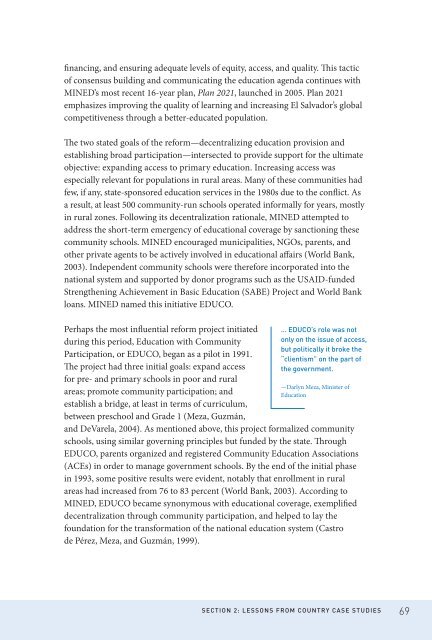The Power of Persistence: Education System ... - EQUIP123.net
The Power of Persistence: Education System ... - EQUIP123.net
The Power of Persistence: Education System ... - EQUIP123.net
Create successful ePaper yourself
Turn your PDF publications into a flip-book with our unique Google optimized e-Paper software.
financing, and ensuring adequate levels <strong>of</strong> equity, access, and quality. This tactic<br />
<strong>of</strong> consensus building and communicating the education agenda continues with<br />
MINED’s most recent 16-year plan, Plan 2021, launched in 2005. Plan 2021<br />
emphasizes improving the quality <strong>of</strong> learning and increasing El Salvador’s global<br />
competitiveness through a better-educated population.<br />
<strong>The</strong> two stated goals <strong>of</strong> the reform—decentralizing education provision and<br />
establishing broad participation—intersected to provide support for the ultimate<br />
objective: expanding access to primary education. Increasing access was<br />
especially relevant for populations in rural areas. Many <strong>of</strong> these communities had<br />
few, if any, state-sponsored education services in the 1980s due to the conflict. As<br />
a result, at least 500 community-run schools operated informally for years, mostly<br />
in rural zones. Following its decentralization rationale, MINED attempted to<br />
address the short-term emergency <strong>of</strong> educational coverage by sanctioning these<br />
community schools. MINED encouraged municipalities, NGOs, parents, and<br />
other private agents to be actively involved in educational affairs (World Bank,<br />
2003). Independent community schools were therefore incorporated into the<br />
national system and supported by donor programs such as the USAID-funded<br />
Strengthening Achievement in Basic <strong>Education</strong> (SABE) Project and World Bank<br />
loans. MINED named this initiative EDUCO.<br />
Perhaps the most influential reform project initiated<br />
during this period, <strong>Education</strong> with Community<br />
Participation, or EDUCO, began as a pilot in 1991.<br />
<strong>The</strong> project had three initial goals: expand access<br />
for pre- and primary schools in poor and rural<br />
areas; promote community participation; and<br />
establish a bridge, at least in terms <strong>of</strong> curriculum,<br />
between preschool and Grade 1 (Meza, Guzmán,<br />
… EdUCO’s role was not<br />
only on the issue <strong>of</strong> access,<br />
but politically it broke the<br />
“clientism” on the part <strong>of</strong><br />
the government.<br />
—Darlyn Meza, Minister <strong>of</strong><br />
<strong>Education</strong><br />
and DeVarela, 2004). As mentioned above, this project formalized community<br />
schools, using similar governing principles but funded by the state. Through<br />
EDUCO, parents organized and registered Community <strong>Education</strong> Associations<br />
(ACEs) in order to manage government schools. By the end <strong>of</strong> the initial phase<br />
in 1993, some positive results were evident, notably that enrollment in rural<br />
areas had increased from 76 to 83 percent (World Bank, 2003). According to<br />
MINED, EDUCO became synonymous with educational coverage, exemplified<br />
decentralization through community participation, and helped to lay the<br />
foundation for the transformation <strong>of</strong> the national education system (Castro<br />
de Pérez, Meza, and Guzmán, 1999).<br />
SECTION 2: lESSONS fROM COUNTRY CASE STUdIES<br />
69

















